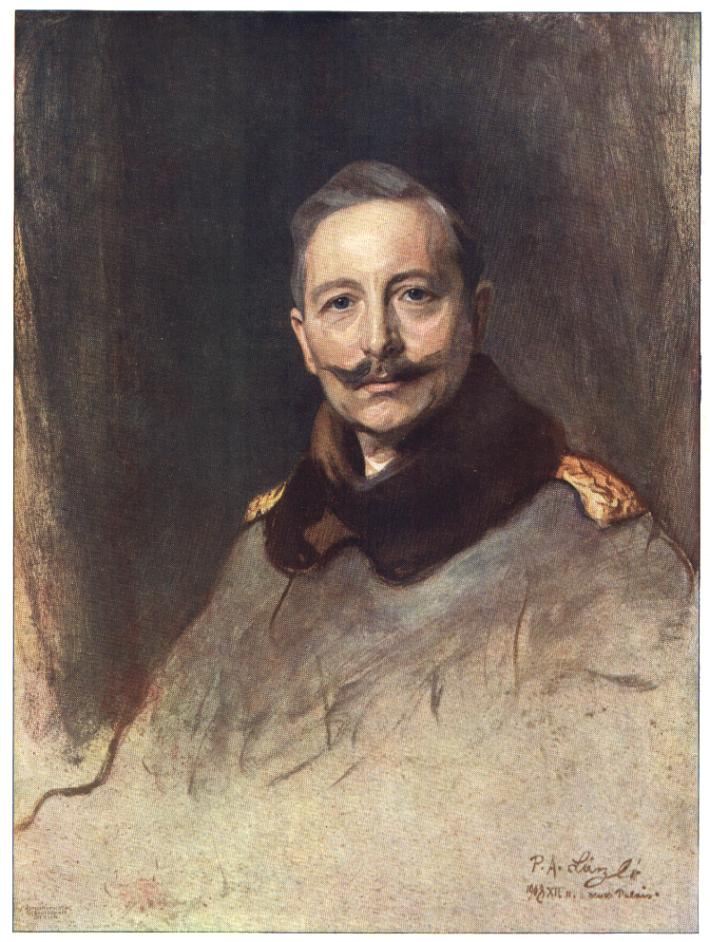   |
   |

Philip de László was no mere society painter. His portraits of Kaiser Wilhelm, Lloyd George and Mussolini went to the heart of a Europe in turmoil. By Giles MacDonogh The Guardian http://www.guardian.co.uk
Finally, while the Kaiser was a guest of the Fürstenbergs at Donaueschingen in November, the head of his military cabinet, Count Hülsen-Haeseler, died of a heart attack after performing a few camped-up pirouettes dressed in a ball gown in an attempt to lift the Kaiser from his gloom. A few days later, Wilhelm had a breakdown; his eldest son had to stand in for him at official functions. It was during his convalescence that László painted his oil sketch of the Kaiser in a grey military coat with a fur collar. It shows an ashen, brow-beaten, but not unsympathetic Kaiser in stark contrast to the bellicose images we have of him. In the early decades of the 20th century, László was one of the leading portrait painters in Europe. He was sought by kings, queens and maharajas; by industrialists, bankers and American presidents (four in all: Roosevelt, Harding, Coolidge and Hoover). Lloyd George sat for him twice, as did the archbishops of Canterbury Randall Davidson and Cosmo Gordon Lang, Austen Chamberlain, and Mussolini, who was described as "a restless sitter", in 1923. And yet, these days László is all but forgotten. A forthcoming exhibition at Christie's in London will be his first retrospective since his death in 1937. How could a painter with 2,700 portraits to his name have come to be so overlooked? De László was born Fülöp László in Budapest in 1869, the son of a brutal, needy tailor. His schooling finished when he was nine, yet, by dint of hard grind and prodigious talent, he managed to establish himself in his 20s as a portrait painter with a European reputation. He married Lucy Guinness, whom he met in Munich in 1892, and made his home in Britain in 1907. His first London exhibition took place at Agnew's that year. Edwardian society took him up with a vengeance and, with the help of sponsors such as Arthur Lee, later Lord Lee of Fareham, the former prime minister Arthur Balfour and the industrialist Lord Devonport, it proved easy to obtain British nationality a few days before the outbreak of war. But the new Briton came under suspicion when nationalism was stirred up by the slaughter on the western front. László had not only painted the Austrian foreign secretary, Count Berchtold, regarded by many as responsible for the war; he had also been ennobled by Emperor Franz Josef in 1912. After warnings, he was arrested in the summer of 1917 and accused of making contact with the enemy by sending letters to his mother and brother. He was locked up in Brixton prison and Holloway internment camp as an enemy alien. László may have painted kaisers and leading central European ministers, but he also portrayed British admirals, including Beatty, generals such as Roberts and Byng, and the press baron Alfred Harmsworth, Lord Northcliffe - the scourge of the Germans. He didn't sympathise with the enemy: the range of his sitters reveals his even-handedness. He was released due to ill-health, but was not vindicated until the summer of 1919. He had been unable to paint anyone outside his own family for two years. His reputation recovered by the following year. Undeniably László had talent: in 1901 the Studio magazine had praised his "charming conception, harmonious colouring, sureness of drawing, intense expression and sound technique". But there is another clue to his success: his talent as a networker. Charmed by the affable painter, sitters would recommend him to friends and relations. That was certainly how László came to paint Kaiser Wilhelm. That work belongs to a private German collection and is absent from the forthcoming exhibition. There is, however, a remarkable equestrian portrait of the Kaiser obtained from the Potsdam Schloesser und Gaerten, a heritage body. Painted after the Kaiser had recovered, in 1910, it depicts him dressed in the uniform of the Cuirassier Guards, standing with his horse and a borzoi dog. It was painted at the summer palace of Wilhelmshöhe, near Cassel - the building in the background, however, shows a slightly inaccurate detail from the New Palace in Potsdam. In the spring of 1945, the portrait aroused the fury of a Soviet soldier as the Red Army took possession of the palace complex in Potsdam. The soldier slashed it four times across the face and torso. For 58 years, the mutilated picture has been in storage in Potsdam, banished, like so many images from its time, because of German embarrassment at the imperial past. There was talk of sending the portrait to Britain in its wounded state, but Potsdam had a change of heart and it was restored for the show. Why did László's reputation sink after the second world war? Christopher Wood, one of the show's curators, suggests that it is because "he was a genuinely European figure who had his own clientele", and blames a prejudice against society painting, pointing out that Sargent, too, was similarly unfashionable for a long time. László's portraits are an encyclopedia of the movers and shakers of his times: for its historical resonance alone, the Christie's exhibition is of major significance. · L¿szl¿: A Brush with Grandeur is at Christie's, London SW1, January 6-22. Details: 020-7839 9060. Useful
links Notes
|
||||

By: Natasha
Wallace
Copyright 1998-2003 all rights
reserved
Created 6/5/2002